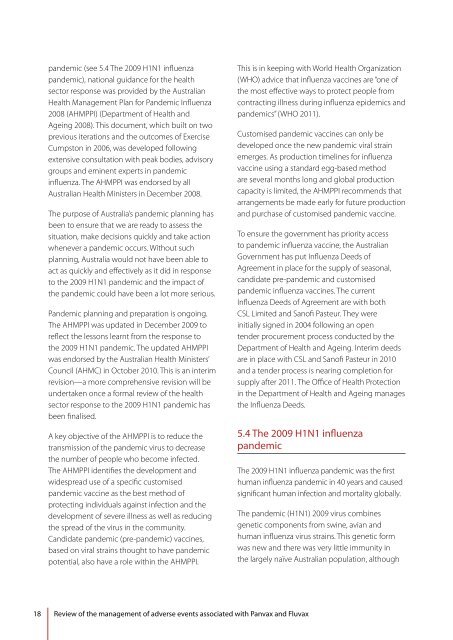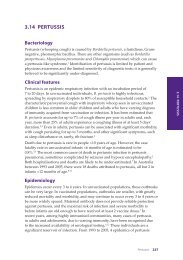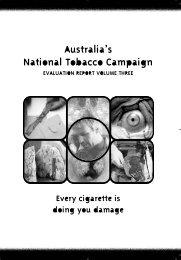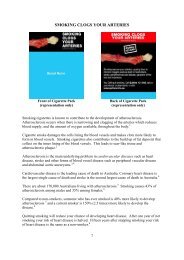Review of the management of adverse effects associated with ...
Review of the management of adverse effects associated with ...
Review of the management of adverse effects associated with ...
You also want an ePaper? Increase the reach of your titles
YUMPU automatically turns print PDFs into web optimized ePapers that Google loves.
pandemic (see 5.4 The 2009 H1N1 influenza<br />
pandemic), national guidance for <strong>the</strong> health<br />
sector response was provided by <strong>the</strong> Australian<br />
Health Management Plan for Pandemic Influenza<br />
2008 (AHMPPI) (Department <strong>of</strong> Health and<br />
Ageing 2008). This document, which built on two<br />
previous iterations and <strong>the</strong> outcomes <strong>of</strong> Exercise<br />
Cumpston in 2006, was developed following<br />
extensive consultation <strong>with</strong> peak bodies, advisory<br />
groups and eminent experts in pandemic<br />
influenza. The AHMPPI was endorsed by all<br />
Australian Health Ministers in December 2008.<br />
The purpose <strong>of</strong> Australia’s pandemic planning has<br />
been to ensure that we are ready to assess <strong>the</strong><br />
situation, make decisions quickly and take action<br />
whenever a pandemic occurs. Without such<br />
planning, Australia would not have been able to<br />
act as quickly and effectively as it did in response<br />
to <strong>the</strong> 2009 H1N1 pandemic and <strong>the</strong> impact <strong>of</strong><br />
<strong>the</strong> pandemic could have been a lot more serious.<br />
Pandemic planning and preparation is ongoing.<br />
The AHMPPI was updated in December 2009 to<br />
reflect <strong>the</strong> lessons learnt from <strong>the</strong> response to<br />
<strong>the</strong> 2009 H1N1 pandemic. The updated AHMPPI<br />
was endorsed by <strong>the</strong> Australian Health Ministers’<br />
Council (AHMC) in October 2010. This is an interim<br />
revision—a more comprehensive revision will be<br />
undertaken once a formal review <strong>of</strong> <strong>the</strong> health<br />
sector response to <strong>the</strong> 2009 H1N1 pandemic has<br />
been finalised.<br />
A key objective <strong>of</strong> <strong>the</strong> AHMPPI is to reduce <strong>the</strong><br />
transmission <strong>of</strong> <strong>the</strong> pandemic virus to decrease<br />
<strong>the</strong> number <strong>of</strong> people who become infected.<br />
The AHMPPI identifies <strong>the</strong> development and<br />
widespread use <strong>of</strong> a specific customised<br />
pandemic vaccine as <strong>the</strong> best method <strong>of</strong><br />
protecting individuals against infection and <strong>the</strong><br />
development <strong>of</strong> severe illness as well as reducing<br />
<strong>the</strong> spread <strong>of</strong> <strong>the</strong> virus in <strong>the</strong> community.<br />
Candidate pandemic (pre-pandemic) vaccines,<br />
based on viral strains thought to have pandemic<br />
potential, also have a role <strong>with</strong>in <strong>the</strong> AHMPPI.<br />
This is in keeping <strong>with</strong> World Health Organization<br />
(WHO) advice that influenza vaccines are “one <strong>of</strong><br />
<strong>the</strong> most effective ways to protect people from<br />
contracting illness during influenza epidemics and<br />
pandemics” (WHO 2011).<br />
Customised pandemic vaccines can only be<br />
developed once <strong>the</strong> new pandemic viral strain<br />
emerges. As production timelines for influenza<br />
vaccine using a standard egg-based method<br />
are several months long and global production<br />
capacity is limited, <strong>the</strong> AHMPPI recommends that<br />
arrangements be made early for future production<br />
and purchase <strong>of</strong> customised pandemic vaccine.<br />
To ensure <strong>the</strong> government has priority access<br />
to pandemic influenza vaccine, <strong>the</strong> Australian<br />
Government has put Influenza Deeds <strong>of</strong><br />
Agreement in place for <strong>the</strong> supply <strong>of</strong> seasonal,<br />
candidate pre-pandemic and customised<br />
pandemic influenza vaccines. The current<br />
Influenza Deeds <strong>of</strong> Agreement are <strong>with</strong> both<br />
CSL Limited and San<strong>of</strong>i Pasteur. They were<br />
initially signed in 2004 following an open<br />
tender procurement process conducted by <strong>the</strong><br />
Department <strong>of</strong> Health and Ageing. Interim deeds<br />
are in place <strong>with</strong> CSL and San<strong>of</strong>i Pasteur in 2010<br />
and a tender process is nearing completion for<br />
supply after 2011. The Office <strong>of</strong> Health Protection<br />
in <strong>the</strong> Department <strong>of</strong> Health and Ageing manages<br />
<strong>the</strong> Influenza Deeds.<br />
5.4 The 2009 H1N1 influenza<br />
pandemic<br />
The 2009 H1N1 influenza pandemic was <strong>the</strong> first<br />
human influenza pandemic in 40 years and caused<br />
significant human infection and mortality globally.<br />
The pandemic (H1N1) 2009 virus combines<br />
genetic components from swine, avian and<br />
human influenza virus strains. This genetic form<br />
was new and <strong>the</strong>re was very little immunity in<br />
<strong>the</strong> largely naïve Australian population, although<br />
18<br />
<strong>Review</strong> <strong>of</strong> <strong>the</strong> <strong>management</strong> <strong>of</strong> <strong>adverse</strong> events <strong>associated</strong> <strong>with</strong> Panvax and Fluvax







